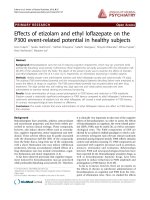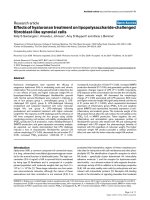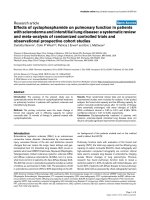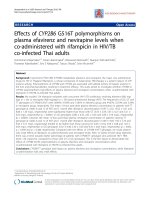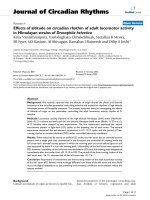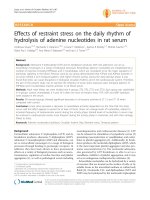Báo cáo y học: "Effects of inosine on reperfusion injury after cardiopulmonary bypass" pps
Bạn đang xem bản rút gọn của tài liệu. Xem và tải ngay bản đầy đủ của tài liệu tại đây (850.46 KB, 6 trang )
RESEARC H ARTIC LE Open Access
Effects of inosine on reperfusion injury after
cardiopulmonary bypass
Gábor Veres
1,2*
, Tamás Radovits
1,3
, Leila Seres
4
, Ferenc Horkay
2
, Matthias Karck
1
, Gábor Szabó
1
Abstract
Objective: Inosine, a break-down product of adenosine has been recently shown to exert inodilatory and anti-
inflammatory properties. Furthermore inosine might be a key substrate of pharmacological post-conditioning. In
the present pre-clinical study, we investigated the effects of inosine on cardiac function during reperfusion in an
experimental model of car dioplegic arrest and extracorporal circulation.
Methods: Twelve anesthetized dogs underwent hypothermic cardiopulmonary bypass. After 60 minutes of
hypothermic cardiac arrest, reperfusion was started after application of either saline vehicle (control, n = 6), or
inosine (100 mg/kg, n = 6). Left ventricular end-systolic pressure volume relationship (ESPVR) was measured by a
combined pressure-volume-conductance catheter at baseline and after 60 minutes of reperfusion. Left anterior
descendent coronary blood flow (CBF), endothelium-dependent vasodilatation to acetylcholine (ACh) and
endothelium-independent vasodilatation to sodium nitroprusside (SNP) were also determined.
Results: The administration of inosine led to a significantly better recovery (given as percent of baseline) of ESPVR
90 ± 9% vs. 46 ± 6%, p < 0.05. CBF and was also significantly higher in the inosine group (56 ± 8 vs. 23 ± 4, ml/
min, p < 0.05). While the vasodilatatory response to SNP was similar in both groups, ACh resulted in a significantly
higher increase in CBF (58 ± 6% vs. 25 ± 5%, p < 0.05) in the inosine group.
Conclusions: Application of inosine improves myocardial and endothelial function after cardiopulmonary bypass
with hypothermic cardiac arrest.
Background
Ischemia-reperfusion injury is a well-known phenom-
enon after cardiac surgery. Independent of the technique
of cardioplegia, temporary dysfunction of biventricular
contractility can frequently be observed. E ven if cardiac
dysfunction is not clinically evident, a reduction of myo-
cardial contractility may occur as described in a study in
humans using pre ssure-volume relationships [1]. In
addition, coronary endothelial dysfunction may further
complicate the postoperative course.
Extra-corporal circulationisalsoknowntoinducea
systemic inflammatory reaction with free radical release
leading to secondary organ injury. During ischemi a, cel-
lular ATP is degraded into AMP, adenosine, inosine and
hypoxanthine. Adenosine and its primary metabolite
inosine are ubiquitous nucleosides that can be released
from ischemic or reperfused tissue [2]. Adenosine and
adenosine analogues have been shown to act as an
endogenous cardio-protective agent against ischemia-
reperfusion injury [3,4]. Until recently, inosine was gen-
erally considered an inactive metabolite. Nevertheless,
some past and recent works suggested that inosine may
exert inotropic, vasodilatory and a nti-inflammatory
effects [5-7]. It has recently been discovered, that
inosine inhibit poly (ADP-ribose) polymerase (PARP)
activation [8]. It is also demonstrated, that PARP acti-
vation occurs during the reperfusion but not during
the ischaemia [9].
As the use of inosine f or prevention of reperfusion
injury in the context of cardiopulmonary bypass has not
yet been investigated, the aim of the present study was
to test the hypothesis that treatment with inosine during
reperfusion improves myocardial, and endothelial func-
tion in a clinically relevant canine model of extracor-
poral circulation.
* Correspondence:
1
Department of Cardiac Surgery, University of Heidelberg, Heidel berg,
Germany
Full list of author information is available at the end of the article
Veres et al. Journal of Cardiothoracic Surgery 2010, 5:106
/>© 2010 Veres et al; licensee BioMed Central Ltd. This is an Open A ccess article dist ributed under the terms of the Creative Commons
Attribution License (htt p://creativecommons.org/licenses/by/2.0), which permits unrestricted use, distribution, an d reproduction in
any medium, pro vided the original work is properly cited.
Methods
Animals
12 dogs (foxhounds) weighing 21 to 35 kg (24.4 ± 1.5
kg) were used in these experiments. All animals received
human care in compliance with the “ Principles of
Laboratory Animal Care” formulated by the National
Society for Medical Research and the “Guide for the
Care and Use of Laboratory Animals” prepared by the
Institute of Laboratory Animal Resources and published
by the National Institutes of Health (NIH Publication
No. 86-23, revised 1996). The experiments were
approved by the Ethical Committee of the Land Baden-
Württemberg for Animal Experimentation.
Surgical preparation and general management
The dogs were premedicated with propionylpromazine
and a nesthetized with a bolus of pentobarbital (15 mg/
kg initial bolus and then 0.5 mg/kg/h i.v.), paralyzed
with pancuronium br omide (0.1 mg/kg as a bolus and
then 0.2 mg/kg/h i.v.) and endotracheally intubated. The
dogs were ventilated with a mixture of room air and O
2
(FiO
2
= 60%) at a frequency of 12-15/min and a tidal
volume starting at 15 ml/kg per minute. The settings
were adjusted by maintaining arterial partial carbondiox-
ide pressure levels between 35-40 mmHg. The femoral
artery and vein were cannulated for recording mean
arterial pressure (MAP) and taking blood samples for
the analysis of blood gases, electrolytes and pH, and
parameters of b lood coagulation. Basic intr avenous
volume s ubstitu tion was carried out with Ringer’ssolu-
tion at a rate of 1 ml/min/kg. If necessary, the rate of
volume substitution was modified according to th e con-
tinuously controlled input-output balance in order to
maintain cardiac output at baseline levels. According to
the values of potassium, bicarbonate and base excess,
substitution in cluded administration of potass ium chlor-
ide and sodium bicarbonate (8.4%). Neither catechola-
minesnorotherhormonalorpressorsubstanceswere
administered. Rectal t emperature and standard periph-
eral electrocardiogram were monitored continuously.
After left anterol ateral thoracotomy in the fourth
intercostal space, pericardiotomy a nd isolation of the
great vessels a perivascular ultrasonic flow probe was
attached to the ascendent aorta. Aortic pressure was
monitored with 5F Millar catheter tip manom eter
(Millar Instruments, Inc., Houston, Tex).
Cardiopulmonary bypass
After systemic anticoagulation with sodium heparin (300
U/kg) the left subclavian artery was cannulated for
arterial perfusion. The venous cannula was placed in the
right atrium. The extracorporeal circuit consisted of a
heat exchanger, a venous reservoir, a roller pump and a
membrane oxygenator primed with Ringer lactate solu-
tion (1000 ml) supplemented with hepa rin (150 U/kg)
and 20 mL sodium bicarbonate (8,4%). Hypothermic
CPB was performed for 90 minutes at a lowest tempera-
ture of 28 °C. After initiation of CPB, the hearts were
arrested with 1000 ml crystalloid cardioplegia (Custo-
diol). Twenty minutes before cross-clamp removal,
rewarming was initiated. After 60 minutes the aortic
crossclamp wa s released and the reperfusion phase was
initiated. All animals were weaned from CPB without
inotropic support. After weaning from CPB, heparin was
antagonized by protamine iv over 10 minutes and the
animals were monitored for one hour. Thereafter, the
hearts were excised for further investigation.
Twenty minutes before cross-clamp removal, rewarm-
ing was initiated. After 60 min of cardiac arrest, the
aorta was declamped, and t he heart was reperfused with
normothermic blood in the bypass circuit. If necessary,
ventricular fibrillation was counteracted with DC cardio-
version of 40 J. Ventilation was restarted with 100% oxy-
gen. All animals were weaned from CPB without
inotropic support 20 min after the release of the aortic
cross clamp. Each animal underwent 90 min of CPB
with 60 min of cardiac arrest.
Experimental groups
Two groups of animals were studied. Group 1 (n = 6)
received placebo, group 2 (n = 6) received 100 mg/kg
inosine during reperfusion. The applied dose of inosine
is based on previous dose-response and pharmacokinetic
studies.
Measurements
Left and right ventricular systo lic pressure (LVSP,
RVSP), maximum and minimum pressure development
(+dP/dt, -dP/dt), end-diastolic pressure (LVEDP,
RVEDP) and cardiac output (CO) as the equivalent of
aortic flow were monitored continuously. Stroke volu me
(SV) was calculated from the integrated flow signal and
was used to calibrate the volume signal from the con-
ductance catheter. Parallel conductance was estimated
by rapid injection of one ml of hypertonic saline into
the pulmonary artery or vena cava superior, respectively.
The volume signal provided by the conductance cathe-
ter was registered continuously (Sigma F5, Leycom,
Leiden, The Netherlands) and computed by the Conduct
PC software (Leycom, Leiden,TheNetherlands).Left
and right ventricular pressure-volume loops were con-
structed on-line. Vena cava occlusions were performed to
obtain a series of loops for calculation of the slope (Ees)
and intercept (V0) of the left and right ventricular end-
systolic pressure-volume relationships. In addition, the
slope of the left ventricular end-systolic pressure-volume
Veres et al. Journal of Cardiothoracic Surgery 2010, 5:106
/>Page 2 of 6
relationship (ESPVR) and preload recruitable stroke work
(PRSW) were c alculated as load-independent indices of
myocardial contractility.
Coronary blood flow (CBF) was measured by an ultra-
sonic flow meter placed on the left anterior descendent
coronary ar tery. Coronary endothelium-dependent vaso-
dilatation was assessed after intracoronary administra-
tion of a single bolus of acetylcholine (ACh, 10
-7
mol)
and endothelium-independent vasodilatation after
administration of sodium-nitroprusside (SNP, 10
-4
mol).
The vasoresponse was expressed as percent change of
baseline coronary blood flow.
Data analysis
All measurements were performed before cardiopulmon-
ary bypass and after 60 min of reperfusion. All values were
expressed as mean * standard error of the mean (SEM).
Paired t-test was used to compare two means within
groups. Individual means between the groups were com-
pared by on e-way analysis o f variance fo llowed by an
unpaired t-test with Bonferroni correction for multiple
comparisons and the post-hoc Scheffe’s test. A probability
value less than 0.05 was considered statistically significant.
In the figures only the significances between the groups
were indicated. S ignificant changes over the t ime within
each group were indicated in the text.
Results
Hemodynamic parameters
Hemodynamic variables are shown in Table 1. Baseline
parameters did not differ between the groups and were
within the physiological range. HR did not change either
in the control or in the ino sine group. After 60 min of
cardioplegic arrest and 60 min of reperfusion, MAP
decreased significantly (p < 0.05) in the control group
while it remained unchanged in the inosine group. CO
did not differ significantly between the groups. However,
it should also be noted that CO showed a clear decreas-
ing tendency within the cont rol group without reaching
the level of significance [Table 1].
Left and right ventricular function
Left ventricular function was identical in both groups at
baseline [Figure 1]. Myocardial contractility-characterized
by the loa d-independent slopes E es and PRSW [Figure 1]
-showed a significant decrease (p < 0.05) after extracor-
poral circulation and reperfusion in the control group
while it remained unchanged in the inosine-treated
group. Representative pressure-volume loops are shown
in Figure 1. Myocardial relaxation constant τ increased
significantly (p < 0.05) in the control group at 60 min of
reperfusion, but it remained at baseline level in the ino-
sine group [Figure 2].
Coronary blood flow and vascular function
Coronary blood flow was similar in both groups before
cardioplegic arrest. After 60 min of reperfusion, coron-
ary blood flow decreased significantly (p < 0.05) in the
control group, but it increased in the inosine group
Table 1 Hemodynamic variables before cardiopulmonary
bypass and after 60 minutes of reperfusion
Baseline 60 minutes of reperfusion
control inosine Control inosine
HR [beats/min] 119 ± 6 108 ± 8 129 ± 9 122 ± 7
MAP [mmHg] 96 ± 8 89 ± 9 67 ± 6° 81 ± 6*
CO [l/min] 2.62 ± 0.32 2.34 ± 0.51 2.10 ± 0.42 2.32 ± 0.77
°p < 0.05 versus before CPB, *p < 0.0 5 versus control.
Figure 1 The effect of inosine on left ventricular contractility.
The slope (Ees) of left ventricular end-systolic pressure-volume
relationships (A) and preload recruitable stroke work (PRSW) (B) are
shown in control and inosine-treated dogs. All values are given as
mean ± SEM, *p < 0.05 vs. control, °p < 0.05 vs. before CPB.
Figure 2 The effect of in osine on d iastolic cardiac function.
Time constant of lerft ventricle decay (Tau) (A) and left ventricle
end-diastolic pressure (LVEDP) (B) are shown in control and inosine-
treated dogs. All values are given as mean ± SEM, *p < 0.05 vs.
control, °p < 0.05 vs. before CPB.
Veres et al. Journal of Cardiothoracic Surgery 2010, 5:106
/>Page 3 of 6
[Figure 3]. Endot helium-dependent vasodilatation after
ACh was significantly (p < 0.05) reduced in the control
group after 60 min of reperfusion in comparison to
values before extracorporal circulation [Figure 3] but
remained unchanged in the inosine group. Endothelium-
independent vasodilatation after SNP showed no signifi-
cant differences over time or between groups [data not
shown].
Discussion
In this study, the benefits of the application of inosine
during reperfusion were assessed after cardiac arrest in
a canine model of extracorporal circulation. We have
shown that inosine improves left ventricle and endothe-
lial function recovery after cardioplegic arrest.
Until recently, inosine was considered an inactive purine
metabolite in most biological systems, but several recent
studies have shown that it has immuno-m odulatory [10],
neuroprotective [11], cardioprotective [12] and overall
cytoprotective effects. Furthermore, some other studies
reported that extracellular inosine has powerful cellular
protective effects. For example, inosin e decreases the
release of intracellular enzymes from hypoxic lymphocytes
[13], improves renal function during ischemia [14] and
inhibits inflammatory cytokine production [7]. Adminis-
tration of inosine has also been shown to improve myocar-
dial function during acute left ventricular failure [15,16]
and improve myocardial and endothelial function after
heart transplantation [12]. Despite the growing evidence
of protective effects of inosi ne, the u se of inosi ne for
prevention of reperfusion injury in the context of cardio-
pulmonary bypass has not yet been investigated.
The most cardiac surgical procedures require cardio-
pulmonary bypass and cardioplegia, which causes ische-
mia-reperfusion injury. Ischemia-reperfusion injury
initiates p athophysiological cascades including an
inflammatory response with liberation of cytokines and
free radicals. Triggered by peroxynitrite-induced DNA
single-brand breaks, PARP catalyzes an energy-
consuming polymerization of ADP-ribose, resulting in
NAD depletion, inhibition of glycolysis, and the reduc-
tion of intracellular high-energy phosphates in the reper-
fuse d heart. In various types of ischemia-reperfusio n, the
prevention of PARP activation results in better preserva-
tion of the high-energy phosphates, resulting in an
improved energy status [17-19]. It is also demonstrated,
that PARP activation occurs during the reperfusion but
not during the ischaemia [20]. Our group demonstrated
previously, that i nosine inhibits PARP activation in vivo
and therefore modulates oxidant-induced cell death [12].
To the best of our knowledge, this was t he first study
that showed the effectiveness of inosine during the reper-
fusion in a clinically relevant large animal model of cardi-
opulmonary bypass. Administration of inosine during the
reperfusion improved both systolic and diastolic indices
of left ventricular contractility. In the current study, the
load-independent indices such as preload recruitable
stroke work (PRSW) and the slope of end-systolic pres-
sure-volume rel ationship (ESPVR) of the left ventricle in
the inosine group remained practically unchanged when
compared with the baseline to 60-minutes reperfusion
values. It is also well known, that the active phase of ven-
tricle relaxation is an energy consuming phase of the car-
diac circle, much like that of contraction. In the present
study, we demonstrated that reperfusion injury is asso-
ciated with impaired cardiac relaxat ion and diastolic dys-
function, as reflected by prolonged time constant of
pressure decay (Tau) and increased LVDP. The decreased
value of Tau in the inosine group clearly showed that
inosine may significantly improve left ventricular diasto-
lic function after CPB.
The increase of coronary blo od flow during reperfu-
sion contributes also to the improvement of cardiac
function. Previous studies demonstrated that inosine
increased coronary flow dose-dependently and, as a con-
sequence, the function of the reperfused heart [21,22].
Our present data is in direct correspondence with these
studies showing significant decrease of the coronary
blood flow in the control group and unchanged CBF-
values in the inosine group after reperfusion. This effect
is comparable to those of with application of nitric
oxide donors [23], endothelin receptor antagonists [24],
or PARP-inhibitors during CPB [9,19,25]. How inosine
protects the endothelium remains not completely
Figure 3 Cor onary endothelial function in vivo. Coronary b lood
flow (CBF) before and after 60 minutes of reperfusion (A).
Endothelium-dependent vasodilatation after intracoronary
administration of a single bolus of acetylcholine (10
-7
mol)
expressed as percent change of coronary blood flow before and
after cardiopulmonary bypass (CPB) at 60 min of reperfusion (B). All
values are given as mean ± SEM; °p < 0.05 versus before CPB, *p <
0.05 versus control.
Veres et al. Journal of Cardiothoracic Surgery 2010, 5:106
/>Page 4 of 6
understood. Previous data suggest that energy depletion
severely impairs endothelial functi on [19]. It also
demonstrated that adenosine and inosine b reakdown
may present an energy source to be preferred over
extracellular glucose under hypoxia, as they delay the
accumulation o f NADH+ H
+
, thereby maintaining some
vital cellular functions. Inosine may exert some of its
cytoprotective effects under ischemia by providing an
emergency energy source, when glucose is insufficient to
support cellular functions . The above hypothesis is sup-
ported both by several reports that cellular ATP levels
were elevated in ischaemic or hypoxic cells treated with
adenosine or inosine [26-30] As inosine restores ATP
levels, this may contribute to improved endothelial func-
tion. If i nosine has a dir ect effect on nitric oxide synth-
esis remains to be clarified.
Conclusions
In summary the results of this study showed that treat-
ment with inosine during the reperfusion markedly
improved post-ischemic myocardial and endothelial
function after cardioplegic arrest in the setting of a car-
diopulmonary bypass. Based on the promising data of
the present study, inosine is supposed to utilize in the
clinical usage. However, further clinical investigations
are needed.
Acknowledgements
This work was supported by grants from the Hungarian Research
Foundation (OTKA 49341).
Author details
1
Department of Cardiac Surgery, University of Heidelberg, Heidel berg,
Germany.
2
Department of Cardiac Surgery, Semmelweis University, Budapest,
Hungary.
3
Heart Center, Semmelweis University, Budapest, Hungary.
4
Gottsegen National Institute of Cardiology, Budapest, Hungary.
Authors’ contributions
All authors have made substantial contributions to conception and design,
or acquisition of data, or analysis and interpretation of data; have been
involved in drafting the manuscript or revisiting it critically for important
intellectual content and have given final approval of the version to be
published.
Competing interests
The authors declare that they have no competing interests.
Received: 17 February 2010 Accepted: 8 November 2010
Published: 8 November 2010
References
1. Wallace A, Lam HW, Nosé PS, Bellows W, Mangano DT: Changes in systolic
and diastolic ventricular function with cold cardioplegic arrest in man.
The Multicenter Study of Perioperative Ischemia (McSPI) Research
Group. J Card Surg 1994, 9(Suppl 3):497-502.
2. Backström T, Goiny M, Lockowandt U, Liska J, Franco-Cereceda A: Cardiac
outflow of amino acids and purines during myocardial ischemia and
reperfusion. J Appl Physiol 2003, 94:1122-1128.
3. Ely SW, Berne RM: Protective effects of adenosine in myocardial ischemia.
Circulation 1992, 85(3):893-904.
4. Veres G, Radovits T, Otila G, Hirschberg K, Haider H, Krieger N, Knoll A,
Weigang E, Szabolcs Z, Karck M, Szabó G: Efficacy of the non-adenosine
analogue A1 adenosine receptor agonist (BR-4935) on cardiovascular
function after cardiopulmonary bypass. Thorac Cardiovasc Surg 2010,
58(2):86-92.
5. Jones CE, Thomas JX, Devous MD, Norris CP, Smith EE: Positive inotropic
response to inosine in the in situ canine heart. Am J Physiol 1977, 233:
H438-443.
6. Schneider A, Zimmer HG: Effect of inosine on function and adenite
nucleotide content of the isolated working rat heart: studies of
postischemic reperfusion. J Cardiovasc Pharmacol 1991, 17:466-473.
7. Haskó G, Kuhel DG, Németh ZH, Mabley JG, Stachlewitz RF, Virag L,
Lohinai Z, Southan GJ, Salzman AL, Szabó C: Inosine inhibits inflammatory
cytokine production by a posttranscriptional mechanism and protects
against endotoxin-induved shock. J Immunol 2000, 164:1013-1019.
8. Virág L, Szabó C: Purines inhibit poly(ADP-ribose) polymerase activation
and modulate oxidant-induced cell death. FASEB J 2001, 15:99-107.
9. Szabó G, Liaudet L, Hagl S, Szabó C: Poly(ADP-ribose) polymerase
activation in the reperfused myocardium. Cardiovasc Res 2004, 61:471-480.
10. Hasko G, Sitkovsky MV, Szabo C: Immunomodulatory and neuroprotective
effects of inosine. Trends Pharmacol Sci 2004, 25:152-157.
11. Spitsin S, Hooper DC, Leist T, Streletz LJ, Mikheeva T, Koprowskil H:
Inactivation of peroxynitrite in multiple sclerosis patients after oral
administration of inosine may suggest possible approaches to therapy
of the disease. Multiple Sclerosis 2001, 7:313-319.
12. Szabó G, Stumpf N, Radovits T, Sonnenberg K, Gerö D, Hagl S, Szabó C,
Bährle S: Effects of inosine on reperfusion injury after heart
transplantation. Eur J Cardiothorac Surg 2006, 30:96-102.
13. Cole AW, Palmer TN: Action of purine nucleosides on the release of
intracellular enzymes from rat lymphocytes. Clin Chim Acta 1979,
92:93-100.
14. Haskó G, Szabó C, Németh ZH, Kvetan V, Pastores SM, Vizi ES: Adenosine
receptor agonists differentially regulate IL-10, TNF-alpha, and nitric
oxide production in RAW 264.7 macrophages and in endotoxemic mice.
J Immunol 1996, 15:4634-40.
15. Smiseth OA: Inosine infusion in dogs with acute ischaemic left
ventricular failure: favourable effects on myocardial performance and
metabolism. Cardiovasc Res 1983, 17:192-9.
16. Woollard KV, Kingaby RO, Lab MJ, Cole AW, Palmer TN: Inosine as a
selective inotropic agent on ischaemic myocardium? Cardiovasc Res 1981,
15:659-6.
17. Virag L, Szabo C: The therapeutic potential of poly(ADP-ribose)
polymerase inhibitors. Pharmacol Rev 2002, 54:375-429.
18. Zingarelli B, Cuzzocrea S, Zsengellér Z, Salzman AL, Szabó C: Protection
against myocardial ischemia and reperfusion injury by 3-
aminobenzamide, an inhibitor of poly(ADP ribose) synthetase. Cardiovasc
Res 1997, 36:205-215.
19. Szabo G, Bahrle S, Stumpf N, Sonneberg K, Szabo E, Pacher P, Csont T,
Schulz R, Dengler TJ, Liaudet L, Jagtap PG, Southan GJ, Vahl CF, Hagl S,
Szabo C: Poly(ADP-ribose) polymerase inhibition reduces reperfusion
injury after heart transplantation. Circ Res 2002, 90:100-106.
20. Szabó G, Soós P, Mandera S, Heger U, Flechtenmacher C, Bährle S, Seres L,
Cziráki A, Gries A, Zsengellér Z, Vahl CF, Hagl S, Szabó C: INO-1001 a novel
poly(ADP-ribose) polymerase (PARP) inhibitor improves cardiac and
pulmonary function after crystalloid cardioplegia and extracorporal
circulation. Shock 2004, 21:426-32.
21. Schneider A, Zimmer HG: Effect of inosine on function and adenite
nucleotide content of the isolated working rat heart: studies of
postischemic reperfusion. J Cardiovasc Pharmacol 1991, 17:466-473.
22. Yoshiyama M, Sakai H, Teragaki M, Takeuchi K, Takeda T, Ikata M,
Ischikawa M, Miura I: The effect of inosine on the post ischemic heart as
bio-energy recovering factor in 31P-MRS. Biochem Biophys Res Commun
1988, 151:1408-1415.
23. Szabó G, Bährle S, Bátkai S, Stumpf N, Dengler TJ, Vahl CF, Hagl S: L-
arginine: effect on reperfusion injury after heart transplantation. World J
Surg 1998, 22:791-798.
24. Szabó G, Fazekas L, Bährle S, Macdonald D, Stumpf N, Vahl CF, Hagl S:
Endothelin-A and -B antagonist protect myocardial and endothelial
function after ischemia/reperfusion in a rat heart transplantation model.
Cardiovasc Res 1998, 39:683-690.
Veres et al. Journal of Cardiothoracic Surgery 2010, 5:106
/>Page 5 of 6
25. Szabó G, Soos P, Heger U, Flechtenmacher C, Bahrle S, Zsengeller Z,
Szabo C, Hagl S: Poly (ADP-ribose) polymerase inhibition attenuates
biventricular reperfusion injury after orthotopic heart transplantation. Eur
J Cardiothorac Surg 2005, 27:226-34.
26. Weinberg JM, Humes HD: Increases of cell ATP produced by exogenous
adenine nucleotides in isolated rabbit kidney tubules. Am J Physiol 1986,
250:F720-33.
27. Takeo S, Tanonaka K, Miyake K, Imago M: Adenine nucleotide metabolites
are beneficial for recovery of cardiac contractile force after hypoxia. J
Mol Cell Cardiol 1988, 20:187-199.
28. Jurkowitz MS, Litsky ML, Browning MJ, Hohl CM: Adenosine, inosine, and
guanosine protect glial cells during glucose deprivation and
mitochondrial inhibition: correlation between protection and ATP
preservation. J Neurochem 1998, 71:535-548.
29. Mandel JL, Takano T, Soltoff SP, Murdaugh S: Mechanisms whereby
exogenous adenine nucleotides improve rabbit renal proximal function
during and after anoxia. J Clin Invest 1998, 81:1255-1264.
30. Módis K, Gero D, Nagy N, Szoleczky P, Tóth ZD, Szabó C: Cytoprotective
effects of adenosine and inosine in an in vitro model of acute tubular
necrosis. Br J Pharmacol 2009, 158:1565-78.
doi:10.1186/1749-8090-5-106
Cite this article as: Veres et al.: Effects of inosine on reperfusion injury
after cardiopulmonary bypass. Journal of Cardiothoracic Surgery 2010
5:106.
Submit your next manuscript to BioMed Central
and take full advantage of:
• Convenient online submission
• Thorough peer review
• No space constraints or color figure charges
• Immediate publication on acceptance
• Inclusion in PubMed, CAS, Scopus and Google Scholar
• Research which is freely available for redistribution
Submit your manuscript at
www.biomedcentral.com/submit
Veres et al. Journal of Cardiothoracic Surgery 2010, 5:106
/>Page 6 of 6

